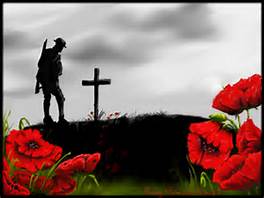 Many of our fellow Fort friends are service veterans and knew people that made the ‘supreme sacrifice’. We should remember and honor all those that have sacrificed their lives so that our country continues to be the beacon of freedom and opportunity.
Many of our fellow Fort friends are service veterans and knew people that made the ‘supreme sacrifice’. We should remember and honor all those that have sacrificed their lives so that our country continues to be the beacon of freedom and opportunity.
It is altogether fitting and proper that we should take a few moments to pay homage to all those men and women who have sacrificed their ‘tomorrows for our todays.’
Many of our older Friends are familiar with IN FLANDERS FIELDS; the World’s Most Famous War Memorial Poem by Lieutenant Col, John McCrae, Canadian Medical Corps.
On May 2, 1915, John McCrae’s close friend and former student Alexis Helmer was killed by a German shell. That evening, in the absence of a Chaplain, John McCrae recited from memory a few passages from the Church of England’s “Order of the Burial of the Dead”. For security reasons Helmer’s burial in Essex Farm Cemetery was performed in complete darkness.
The next day, May 3, 1915, Sergeant-Major Cyril Allinson was delivering mail. McCrae was sitting at the back of an ambulance parked near the dressing station beside the Yser Canal, just a few hundred yards north of Ypres, Belgium. He was the first person to ever read the poem and remarked, “The poem was an exact description of the scene in front of us both. He used the word blow in that line because the poppies actually were being blown that morning by a gentle east wind.”
On 29 September 1920, the National American Legion convened in Cleveland. The Convention agreed on the use of the Flanders Fields Memorial Poppy as the United States’ National emblem of Remembrance.
We invite you to read and contemplate the message of ‘In Flanders Fields’.
If you want to hear a YouTube recitation of the Poem by Sir John Gielgud click HERE
IN FLANDERS FIELDS
the World’s Most Famous War Memorial Poem
by Lieutenant Col, John McCrae,
Canadian Medical Corps
In Flanders fields the poppies blow
Between the crosses, row on row,
That mark our place: and in the sky
The larks still bravely singing fly
Scarce heard amid the guns below.
We are the dead: Short days ago,
We lived, felt dawn, saw sunset glow,
Loved and were loved: and now we lie
In Flanders fields!
Take up our quarrel with the foe
To you, from failing hands, we throw
The torch: be yours to hold it high
If ye break faith with us who die,
We shall not sleep, though poppies grow
In Flanders fields.
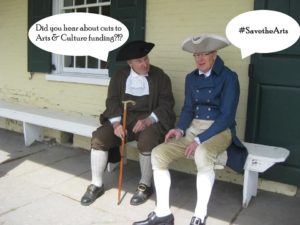 These are challenging times for all of us – both personally and professionally. Visitor-facing cultural organizations have lost earned income streams with an uncertain future as communities recover from the pandemic and necessary shut-down.
These are challenging times for all of us – both personally and professionally. Visitor-facing cultural organizations have lost earned income streams with an uncertain future as communities recover from the pandemic and necessary shut-down.
Facing a recovery period against the backdrop of reduced or eliminated government support for arts and culture will mean that many organizations will be unable to recover. Think about how these organization enrich life for your family and imagine a world without many of them. This could be the future if we do not advocate for continued support of arts and culture in State and City budgets. Please contact your State Legislature representative and City Council representative and urge continued support for the Pennsylvania Historical and Museum Commission and the Philadelphia Cultural Fund.
Together we can #SaveTheArts.
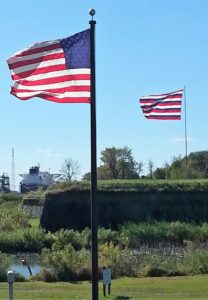 A symbol is something that represents or stands for something else – often an idea or abstract concept. The American flag is an easily recognized symbol of patriotism, its meaning extending beyond the 13 stripes for 13 colonies and 50 stars for 50 states. The federal courts determined that the American flag is “the symbol of our national unity, transcending all internal differences however large, within the framework of our Constitution.” This symbol of our national life goes to battle with soldiers, flies at sporting events, over post offices, schools and the White House. It honors fallen heroes inspires bravery and pride.
A symbol is something that represents or stands for something else – often an idea or abstract concept. The American flag is an easily recognized symbol of patriotism, its meaning extending beyond the 13 stripes for 13 colonies and 50 stars for 50 states. The federal courts determined that the American flag is “the symbol of our national unity, transcending all internal differences however large, within the framework of our Constitution.” This symbol of our national life goes to battle with soldiers, flies at sporting events, over post offices, schools and the White House. It honors fallen heroes inspires bravery and pride.
Francis Scott Key penned the Star Spangled Banner after being inspired by seeing the flag waving over Fort McHenry following intense British bombardment during the War of 1812. Years before, in 1777, the Fort Mifflin flag remained flying throughout the British throughout the siege and bombardment here.
Flag Day commemorates the official adoption of the flag of the United States by the Second Continental Congress on June 14, 1777. President Woodrow Wilson issued a proclamation honoring the anniversary of the flag resolution in 1916, and congress officially designated June 14 as National Flag Day in 1949.
The Fort Mifflin Flag
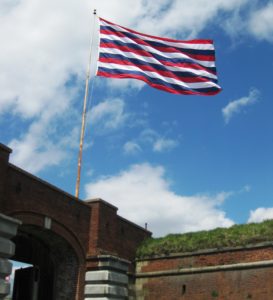 The distinctive Fort Mifflin flag was also an official flag of the Continental Navy. Lacking the familiar blue union field of stars, it consists of alternating stripes of red, white and blue representing the thirteen states of the new nation. The flag typically flown at the Fort is a large garrison flag, about half the size of the flag at Fort McHenry flag of the War of 1812 (the “Star Spangled Banner”) and could be seen 7 miles away in Philadelphia.
The distinctive Fort Mifflin flag was also an official flag of the Continental Navy. Lacking the familiar blue union field of stars, it consists of alternating stripes of red, white and blue representing the thirteen states of the new nation. The flag typically flown at the Fort is a large garrison flag, about half the size of the flag at Fort McHenry flag of the War of 1812 (the “Star Spangled Banner”) and could be seen 7 miles away in Philadelphia.
During the siege and bombardment of Fort Mifflin (October 6 – November 15, 1777) the flag was kept flying despite the British bombardment, the greatest of the American Revolution. Although at one point British cannonballs were falling into the fort at the rate of 1,000 an hour, General Washington ordered the American garrison to “hold to the last extremity.” Two brothers from Pennsylvania, Sergeant Andrew Mackemson and Lieutenant James Mackemson, were both killed in re-raising the shot torn flag. The fort was finally evacuated by the last defenders early in the morning of November 16th, but was never surrendered to the British. The Fort Mifflin flag was still flying to the end.
Design your own flag! Click HERE to get some ideas and a special reward if you bring your flag to Fort Mifflin.
Want to learn more?
Learn how to respectfully handle the American Flag
Learn the story of the Star Spangled Banner
Betsy Ross or Francis Hopkinson?
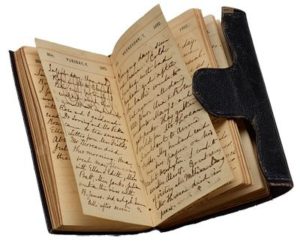 How do historians learn what really happened in the past? There are many ways to learn this information, but the most valuable way is through the study of primary sources. A primary source is an original piece of information created at the time under study such as a diary, letter, newspaper article including eye witness accounts, or public record, artwork, photograph or literature. Even archaeological artifacts are primary sources!
How do historians learn what really happened in the past? There are many ways to learn this information, but the most valuable way is through the study of primary sources. A primary source is an original piece of information created at the time under study such as a diary, letter, newspaper article including eye witness accounts, or public record, artwork, photograph or literature. Even archaeological artifacts are primary sources!
Secondary sources can also be helpful. They often include primary source information with additional comments or analysis. An example of a secondary source would be a magazine or newspaper article written to honor an anniversary of an event.
When doing historic research it is important to include primary sources so that you have examined direct links to the past. We are living through an historic time right now! How will future historians learn what life in quarantine during the COVID-19 pandemic was like? There will be the newspaper articles (in print and online) and recordings of the news broadcasts and hospital records, but how will they know what day-to-day life during the “stay at home” order was like? You can tell them!
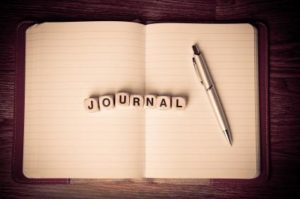 Journals are personal accounts of history. Do you keep one? Do you post on any social media? Then you are creating a primary source for future historians!
Journals are personal accounts of history. Do you keep one? Do you post on any social media? Then you are creating a primary source for future historians!
Print out this journal cover and put 4 or 5 additional pieces of blank paper on top, then fold in half to make a booklet. Put 2 or 3 staples very close to the fold to hold it all together.
Try keeping a daily record of your activities, thoughts and feelings for a whole week! Be sure to put the date at the top of each entry. Write down not only the basic information about what you did but also how you were feeling. What made you laugh today? Did you see something that made you sad when you saw a news segment on TV? Did your family eat a special meal together? How have your activities changed since before self-quarantine? Did you use Facetime or Zoom to keep in touch with friends or family members you are not able to see in person? Did you celebrate any special occasions like a birthday or graduation? How did you celebrate in a creative or unusual way? See if you can get other family members to keep a journal for the week, too. At the end of the week compare your entries — do you each have a unique perspective on the same activities?
Learn more!
Read an article with journal entries and photographs from the 1918 influenza epidemic https://www.smithsonianmag.com/history/what-we-can-learn-1918-influenza-diaries-180974614
Explore primary sources – what do YOU want to learn about? https://www.edutopia.org/blog/online-resources-primary-source-documents-monica-burns
Make history! Submit your story: https://medium.com/history-made-by-us/you-are-the-primary-source-211c33053bcf

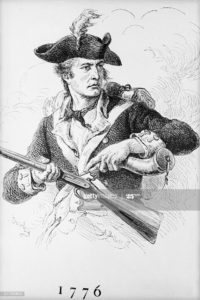
Soldier of 1776 filling his gun from powder horn. Undated engraving.
The Revolutionary War was fought on both sides of the battle lines by armies equipped with smooth bore, muzzle loading flintlock muskets. Cartridges rolled out of paper and filled with a musket ball and black powder were individually loaded and down the muzzle of the musket, packed at the breach with a ram-rod and fired by igniting a small amount of black powder in the priming pan. A good soldier could load and fire his weapon three or four times per minute.
None of this worked very well if the black powder got wet, so it was important to keep your powder dry! Prepared cartridges were carried in a leather cartridge box and loose black powder was often carried in a hollow horn of an ox or cow, fitted with a cover and a strap to carry it.
George Washington’s Continental Army had a lot of trouble getting enough black powder to keep the soldiers and artillery properly supplied. Almost all the black powder used during the American Revolution had to be imported from France or the French West Indies. One of the only working black powder mills in America was the Frankford Powder Mill, in what is now part of Philadelphia!
Black powder is a mixture of three ingredients. This means that each ingredient remains distinct within the formula. They were ground together in mills, much like a grain mill. Powder mills were powered by wind or water and located away from heavily populated areas because of the risk of accidental explosion.
You can keep your powder dry in a powder horn that you create out of simple materials you probably have at home!
You will need: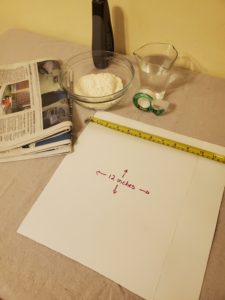
- 12-inch square of poster board or similar material – I used an old gift box that I cut to size!
- Tape
- Scissors
- 6 pages of newspaper
- ½ cup of flour
- 1 cup water
- Bowl
- Whisk
- Craft paint and paintbrush
- Marker
- 36 to 48 inches of string, yarn or ribbon
This is a fun but messy project, so cover your work surface with an old tablecloth, extra newspaper or a garbage bag.
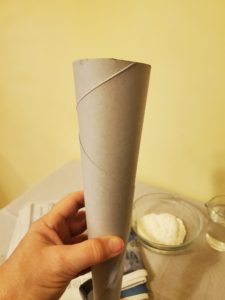 Roll the poster board into a cone shape and tape it to hold together – a staple at the wide end is helpful. Trim the wide end so that it is flat and even.
Roll the poster board into a cone shape and tape it to hold together – a staple at the wide end is helpful. Trim the wide end so that it is flat and even.
Tear the newspaper into strips about 2 inches wide.
Mix the flour and water in the bowl.
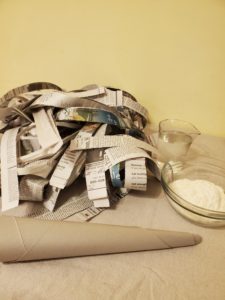 Wet several strips of newspaper at a time in the flour mixture. Take one strip at a time out, wipe off the excess liquid and apply it to the cone. As you build layers, try and smooth them out. Add strips to the narrow end and twist them up to make the curved point.
Wet several strips of newspaper at a time in the flour mixture. Take one strip at a time out, wipe off the excess liquid and apply it to the cone. As you build layers, try and smooth them out. Add strips to the narrow end and twist them up to make the curved point.
When you are pleased with the shape, set it aside on a plastic bag to dry overnight. Don’t forget to clean up your mess!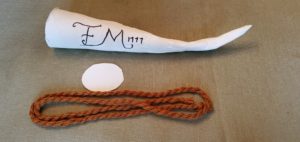
The next day, trace the open end on a scrap of poster board and cut this out to make the lid.
Paint everything! Horns were naturally an off-white to light tan color but you can decide what color you want based on what color paint you have at home. When the paint is dry you can decorate it with the marker.
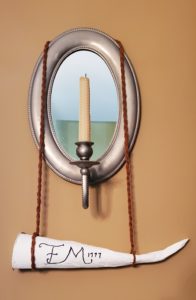 Soldiers often carved things in their powder horns during long winter days in camp. They might carve their initials or name, battles they fought in, or popular expressions. How will you decorate yours?
Soldiers often carved things in their powder horns during long winter days in camp. They might carve their initials or name, battles they fought in, or popular expressions. How will you decorate yours?
Attach the lid with a piece of tape or string attached through a hole in the top of the horn. Then attach your carrying string and you are ready to join General Washington!
Learn more!
Read about the gunpowder supply in the American Revolution
Discover the powder horn that belonged to an African American patriot.
And watch this video from the American Battlefield Trust.
 Many of our fellow Fort friends are service veterans and knew people that made the ‘supreme sacrifice’. We should remember and honor all those that have sacrificed their lives so that our country continues to be the beacon of freedom and opportunity.
Many of our fellow Fort friends are service veterans and knew people that made the ‘supreme sacrifice’. We should remember and honor all those that have sacrificed their lives so that our country continues to be the beacon of freedom and opportunity.









